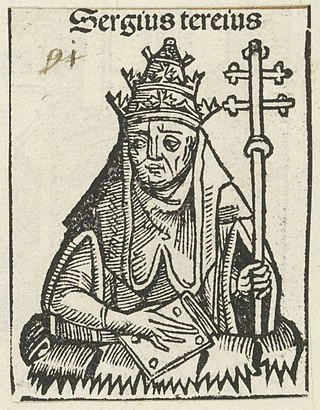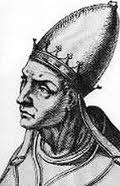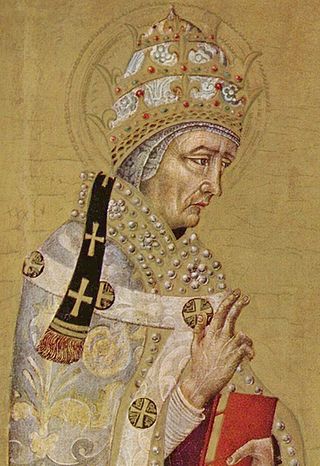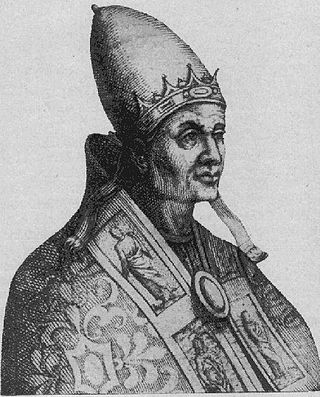Related Research Articles

Pope Agapetus II was the bishop of Rome and ruler of the Papal States from 10 May 946 to his death. A nominee of the princeps of Rome, Alberic II of Spoleto, his pontificate occurred during the period known as the Saeculum obscurum.
Pope Marinus II was the bishop of Rome and ruler of the Papal States from 30 October 942 to his death. He has also been mistakenly called Martinus III. He ruled during the Saeculum obscurum. He was also erroneously called Martin III leading to the second pope named Martin taking the name Martin IV.

Pope Benedict V was the pope and ruler of the Papal States from 22 May to 23 June 964, in opposition to Leo VIII. He was overthrown by Emperor Otto I. His brief pontificate occurred at the end of a period known as the Saeculum obscurum.

Pope Gregory IV was the bishop of Rome and ruler of the Papal States from October 827 to his death. His pontificate was notable for the papacy’s attempts to intervene in the quarrels between Emperor Louis the Pious and his sons. It also saw the breakup of the Carolingian Empire in 843.
Pope Stephen III was the bishop of Rome and ruler of the Papal States from 7 August 768 to his death. Stephen was a Benedictine monk who worked in the Lateran Palace during the reign of Pope Zachary. In the midst of a tumultuous contest by rival factions to name a successor to Pope Paul I, Stephen was elected with the support of the Roman officials. He summoned the Lateran Council of 769, which sought to limit the influence of the nobles in papal elections. The Council also opposed iconoclasm.
Pope Stephen IV was the bishop of Rome and ruler of the Papal States from June 816 to his death. Stephen belonged to a noble Roman family. In October 816, he crowned Louis the Pious as emperor at Reims, and persuaded him to release some Roman political prisoners he held in custody. He returned to Rome, by way of Ravenna, sometime in November and died the following January.
Pope Stephen VII was the bishop of Rome and nominal ruler of the Papal States from February 929 to his death in 931. A candidate of the infamous Marozia, his pontificate occurred during the period known as the Saeculum obscurum.

Pope Sergius III was the bishop of Rome and nominal ruler of the Papal States from 29 January 904 to his death. He was pope during a period of violence and disorder in central Italy, when warring aristocratic factions sought to use the material and military resources of the papacy. At the behest of Theophylact I of Tusculum, Sergius seized the papal throne from Antipope Christopher, who in turn had deposed Pope Leo V. Sergius' reign was subsequently marked by Theophylact's influence. As pope, Sergius continued many ecclesiastical controversies of his predecessors, including conflict over Pope Formosus' legacy, annulling all ordinations made by the late pope, and the filioque controversy with eastern patriarchs. His pontificate was similarly marked by temporal conflicts, with Sergius' refusal to crown Berengar I of Italy as Holy Roman Emperor, and his support of Byzantine Emperor Leo VI the Wise's fourth marriage. Sergius also saw the restoration of the Lateran Palace.

Pope Leo VIII was a Roman prelate who claimed the Holy See from 963 until 964 in opposition to John XII and Benedict V and again from 23 June 964 to his death. Today he is considered by the Catholic Church to have been an antipope during the first period and the legitimate Pope of Rome during the second. An appointee of Holy Roman Emperor Otto I, Leo VIII's pontificate occurred after the period known as the saeculum obscurum.
Pope Leo V was the bishop of Rome and nominal ruler of the Papal States from July 903 to his death in February 904. He was pope immediately before the period known as the Saeculum obscurum, when popes wielded little temporal authority.
Pope Leo VI was the bishop of Rome and nominal ruler of the Papal States for just over seven months, from June 928 to his death. His pontificate occurred during the period known as the Saeculum obscurum.
Pope John XIII was the bishop of Rome and ruler of the Papal States from 1 October 965 to his death. His pontificate was caught up in the continuing conflict between the Holy Roman emperor, Otto I, and the Roman nobility. After long and arduous negotiations, he succeeded in arranging a Byzantine marriage for Otto II, in an effort to legitimize the Ottonian claim to imperial dignity. He also established church hierarchy in Poland and Bohemia.
Pope John XII, born Octavian, was the bishop of Rome and ruler of the Papal States from 16 December 955 to his death in 964. He was related to the counts of Tusculum, a powerful Roman family which had dominated papal politics for over half a century. He became pope in his late teenage years or early twenties. In 960, he clashed with the Lombards to the south. Unable to control Rome easily, he sought help from King Otto I of Germany and crowned him emperor. John XII's pontificate became infamous for the alleged depravity and worldliness with which he conducted his office. He soon fell out with Otto, but died before Otto succeeded in his attempt to depose him.
Pope John XI was the bishop of Rome and nominal ruler of the Papal States from March 931 to his death. The true ruler of Rome at the time was his mother, Marozia, followed by his brother Alberic II. His pontificate occurred during the period known as Saeculum obscurum.
Pope John X was the bishop of Rome and nominal ruler of the Papal States from March 914 to his death. A candidate of the counts of Tusculum, he attempted to unify Italy under the leadership of Berengar of Friuli, and was instrumental in the defeat of the Saracens at the Battle of Garigliano. He eventually fell out with Marozia, who had him deposed, imprisoned, and finally murdered. John’s pontificate occurred during the period known as the Saeculum obscurum.

Saeculum obscurum, also known as the Pornocracy or the Rule of the Harlots, was a period in the history of the Papacy during the first two-thirds of the 10th century, following the chaos after the death of Pope Formosus in 896 which saw seven or eight papal elections in as many years. It began with the installation of Pope Sergius III in 904 and lasted for sixty years until the death of Pope John XII in 964. During this period, the popes were influenced strongly by a powerful and allegedly corrupt aristocratic family, the Theophylacti, and their relatives and allies. The era is seen as one of the lowest points of the history of the Papal office.
Theophylact I was a medieval count of Tusculum who was the effective ruler of Rome from around 905 through to his death in 924. His descendants controlled the papacy for the next 100 years.
Alberic I was the Lombard Duke of Spoleto from between 896 and 900 until 920, 922, or thereabouts. He was also Margrave of Camerino, and the son-in-law of Theophylact I, Count of Tusculum, the most powerful man in Rome.

The selection of the pope, the bishop of Rome and supreme pontiff of the Roman Catholic Church, prior to the promulgation of In nomine Domini in 1059 varied throughout history. Popes were often appointed by their predecessors or by political rulers. While some kind of election often characterized the procedure, an election that included meaningful participation of the laity was rare, especially as the popes' claims to temporal power solidified into the Papal States. The practice of papal appointment during this period would later result in the jus exclusivae, i.e., a right to veto the selection that Catholic monarchs exercised into the twentieth century.

The Tusculan Papacy was a period of papal history from 1012 to 1048 where three successive relatives of the counts of Tusculum were installed as pope.
References
- Mann, Horace K., The Lives of the Popes in the Early Middle Ages, Vol. IV: The Popes in the Days of Feudal Anarchy, 891-999 (1910)